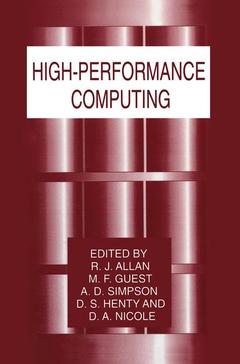High-Performance Computing, Softcover reprint of the original 1st ed. 1999
Langue : Anglais
Coordonnateurs : Allan R.J., Guest M.F., Simpson A.D., Henty D.S., Nicole D.

Over the past decade high performance computing has demonstrated the ability to model and predict accurately a wide range of physical properties and phenomena. Many of these have had an important impact in contributing to wealth creation and improving the quality of life through the development of new products and processes with greater efficacy, efficiency or reduced harmful side effects, and in contributing to our ability to understand and describe the world around us. Following a survey ofthe U.K.'s urgent need for a supercomputingfacility for aca demic research (see next chapter), a 256-processor T3D system from Cray Research Inc. went into operation at the University of Edinburgh in the summer of 1994. The High Performance Computing Initiative, HPCI, was established in November 1994 to support and ensure the efficient and effective exploitation of the T3D (and future gen erations of HPC systems) by a number of consortia working in the "frontier" areas of computational research. The Cray T3D, now comprising 512 processors and total of 32 CB memory, represented a very significant increase in computing power, allowing simulations to move forward on a number offronts. The three-fold aims of the HPCI may be summarised as follows; (1) to seek and maintain a world class position incomputational scienceand engineering, (2) to support and promote exploitation of HPC in industry, commerce and business, and (3) to support education and training in HPC and its application.
The U.K. High-Performance Computing Initiative: Introduction; R.J. Allan, et al. Science Support from the EPCC HPCI Centre; A.D. Simpson, D.S. Henty. The CLRC HPCI Centre at Daresbury Laboratory; R.J. Allan, et al. Southampton High Performance Computing Centre; D.A. Nicole, et al. Optimisation, Algorithms and Software: Performance Optimisation on the Cray T3E; S. Booth. From FLOPS to UDAPS: Algorithms, Benchmarking and Tuning; N. MacLaren. Is Predictive Tracing too late for HPC Users? D. J. Kerbyson, et al. Solving Dense Symmetric Eigenproblems on the Cray T3D; K. Murphy, et al. PARASOL: An Integrated Programming Environment for Parallel Sparse Matrix Solvers; P. Amestoy, et al. Computational Modelling of Multi-Physics Processes on High Performance Parallel Computer Systems; M. Cross, et al. Porting Industrial Codes to MPP Systems using HPF; M. Delves. Decomposition Independence in Parallel Programs; S. Booth. Software Portability and Maintenance; K. Takeda, et al. A Design Environment for Structured Mapping of Signal Processing Applications on Parallel Processors; M. Razaz. Materials Chemistry and Simulation: New Vistas for First-Principles Simulation; G. Ackland, et al. On the Quasi-Particle Spectra of YBa2Cu3O7; W.M. Temmerman, et al. Ab initio Studies of Hydrogen Molecules in Silicon; B. Hourahine, et al. Quantum Monte Carlo Simulations of Real Solids; W.M.C. Foulkes, et al. Ab initio Investigations of the Dynamical Properties of Ice; I. Morrison, et al. Phase Separation of Two Immiscible Liquids; S.I. Jury, et al. Computer Simulation of Liquid Crystals on the T3D/T3E; M.R. Wilson, et al. A First Principles Study of Substitutional Gold in Germanium; J. Coomer, et al. Applications of Self-Interaction Correction to Localized States in Solids; Z. Szotek, et al. Computational Chemistry: Computational Chemistry in the Environmental Molecular Sciences Laboratory; D.A. Dixon, et al. Macromolecular Modelling on the Cray T3D; M.D. Cooper, et al. Accurate Configuration Interaction Computations of Potential Energy Surfaces using Massively Parallel Computers; A.J. Dobbyn, P. Knowles. Molecular Properties from First Principles; C.J. Adam, et al. Massive Parallelism: The Hardware for Computational Chemistry? M.F. Guest, et al. Atomic Physics: The Multiphoton and Electron Collisions Consortium and the Helium Code; K.T. Taylor, et al. Application of 6DIME: (&ggr;,2e) on He; J. Rasch, et al. Parallelisation of Atomic R-Matrix Scattering Programs; A. Sunderland, et al. Partial Wave Integrals; J. Rasch, C.T. Whelan. Molecular Rotation-Vibration Calculations using Massively Parallel Computers; H.Y. Mussa, et al. Environmental Modelling: Modelling Climate Variability on HPC Platforms; L. Steenman-Clark, A. O'Neill. The U.K Ocean Circulation and Advanced Modelling Project (OCCAM); B.A. de Cuevas, et al. The Southampton - East Anglia (SEA) Model: A General Purpose Parallel Ocean Circulation Model; M. Beare. High Resolution Modelling of Airflow over the Isle of Arran; A. Gadian, et al. Development of Portable Shelf Sea Models for Massively Parallel Machines; R. Proctor, et al. Satellite Altimeter Data Assimilation in the OCCAM Global Ocean Model; A.D. Fox, et al. Parallelisation and Performance of a Stratospheric Chemical Transport Model; C. Bridgeman. Supe
Date de parution : 10-2012
Ouvrage de 584 p.
15.5x23.5 cm
Disponible chez l'éditeur (délai d'approvisionnement : 15 jours).
Prix indicatif 158,24 €
Ajouter au panierThème de High-Performance Computing :
Mots-clés :
Diallylphthalat; Phenoplaste; Polycarbonat; Potential; Resol; processor
© 2024 LAVOISIER S.A.S.
